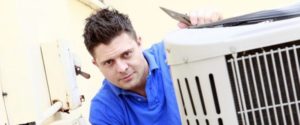Air Conditioning: A Brief History
The first notable attempts humans have made (on a large scale) to cool structures and homes were back in ancient Rome. Cool water from Rome’s famous aqueduct system was routed to circulate in through the walls of upper-class citizen’s homes. Other attempts were made to cool the masses throughout early history, but attempts at Air Conditioning all but ceased during the dark ages. Some clever attempts are seen in medieval architecture such as ‘wind towers’, where wind was channeled to circulate around a large open area and then through the large open corridors of castles.
It wasn’t until 1902 that the first modern air conditioning system (similar to what we see today) was invented by New Yorker, Willis Carrier. Carrier’s first air conditioner worked on the principle of directing air through coils that were water cooled and was invented as a humidity control in industrial applications rather than to cool homes. Carrier’s first invention was developed for and used in a paper factory where Carrier worked at the time. In 1922, Carrier improved his air conditioner by inventing the centrifugal chiller with a central compressor similar to the technology used in air conditioners today. And then in 1925, Carrier introduced his air conditioning unit to the public. This unit being large and expensive still wasn’t practical for home cooling, but quickly caught on in large venues like movie theaters, department stores, office buildings throughout the 1930’s. It would take some time before air conditioning systems were scaled-down and streamlined to be practical in home use, and an even longer time for the (then considered luxury) to become popular as a standard fixture in american home construction. The Carrier Corporation sites about residential air conditioning, that “as late as 1965, just 10 percent of U.S. homes had it”. But by 2007, the popularity and affordability of air conditioning put that number to 87 percent of homes in the United States that were equipped.
Refrigerant And How It Works
Most commonly, refrigerant is a fluid used in a heat pump and refrigeration cycle. The refrigerant phase transitions from gas to liquid and back again in a cycle. This cycle transfers heat from a cool reservoir to a hot or high temperature reservoir. Typically, air is then directed through coil components related to the cool reservoir where the air is cooled to facilitate refrigeration. The process is usually driven mechanically and this method of application is used in industrial freezers, refrigerators, and air conditioning to name a few.
HVAC Technicians
HVAC technicians specialize in the repair, maintenance, and installation of HVAC systems. Before becoming an HVAC technician, a thorough knowledge and familiarity with the use of a variety of tools (including power tools) is a must. HVAC technicians are also required to have a firm working knowledge of systems, controls, piping, wiring, laws regarding building code, and troubleshooting.
 HVAC technicians receive formal or technical training usually accompanied by an associates degree, diploma, or certification. This training can be gained through an on-the-job apprenticeship, a short-term vocational course, through a community college, through a certification program at a technical college, or an accredited course through a trade school. During an HVAC technicians training, the technician attends regular classroom lectures and didactic hands-on training through practical labs. Typically after graduation and/or technical certification, the HVAC technician’s hands-on training continues through an apprenticeship under the supervision and guide of a professional HVAC technician. Upon completion of the HVAC technician’s apprenticeship and certification, most states in the U.S. require HVAC technicians to be licensed. The state licensing typically requires the HVAC technician candidate pass a written exam, demonstrating competence and a thorough knowledge of Industry, State, and Federal standards. There are also a number of specialty certifications an HVAC technician may be required to hold before working with specific equipment or contracts.
HVAC technicians receive formal or technical training usually accompanied by an associates degree, diploma, or certification. This training can be gained through an on-the-job apprenticeship, a short-term vocational course, through a community college, through a certification program at a technical college, or an accredited course through a trade school. During an HVAC technicians training, the technician attends regular classroom lectures and didactic hands-on training through practical labs. Typically after graduation and/or technical certification, the HVAC technician’s hands-on training continues through an apprenticeship under the supervision and guide of a professional HVAC technician. Upon completion of the HVAC technician’s apprenticeship and certification, most states in the U.S. require HVAC technicians to be licensed. The state licensing typically requires the HVAC technician candidate pass a written exam, demonstrating competence and a thorough knowledge of Industry, State, and Federal standards. There are also a number of specialty certifications an HVAC technician may be required to hold before working with specific equipment or contracts.
For instance, some HVAC technicians specialize in residential systems whereas others may specialize in commercial systems. Furthermore, all HVAC technicians in the United States must be certified federally with the EPA to work with and handle refrigerants. Even then, there are four levels of certification the EPA requires for various activities in which the HVAC technician is involved. All of Air National Texas’ technicians are EPA certified, registered with the state, experienced, background checked, and go through regular training.


